Conducting quality justice system research for Idaho since 1976.
The Idaho Statistical Analysis Center (ISAC) resides within the Pass-Through Grants and Research Department of the Idaho State Police. The overall purpose of ISAC, as established by the U.S. Bureau of Justice Statistics, is the systematic collection, analysis, and dissemination of statistics related to crime, illegal drugs, victim services, and the administration of justice. ISAC provides criminal justice agencies and community organizations access to research reports, data dashboards, and other statistical information that can be used for development and analysis of justice system policies, operations, and programs.
Recent Publications
Research Briefs
Drug & Alcohol Related Crime Trends, 2005 – 2024
August 2025
Intimate Partner Violence in Idaho, 2023
April 2025
Sexual Violence in Idaho, 2023
April 2025
Sexual Violence in Idaho: Prevalence and Health Impacts
November 2024
Juvenile Crime
School Resource Officers in Idaho
June 2025
Justice System Performance
2024 Idaho Justice System Stakeholder Survey
October 2024
Upcoming Publications
Spring 2026
- Justice System Performance
- Update on Idaho’s Substance Misuse Data
- Research Briefs
- Intimate Partner Violence in Idaho, 2024
- Sexual Violence in Idaho, 2024
Summer 2026
- Research Briefs
- Drug and Alcohol Related Crime, 2025
Idaho Statistical Analysis Center
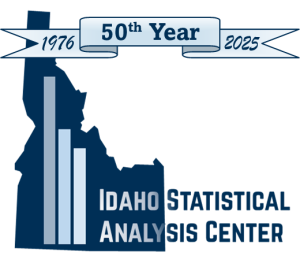
Thomas Strauss
ISAC Director & Principal Research Analyst
700 S. Stratford Dr.
Meridian, ID 83642
208-884-7047
Kourtnie Rodgers
Senior Research Analyst
208-884-7044
Data Dashboards
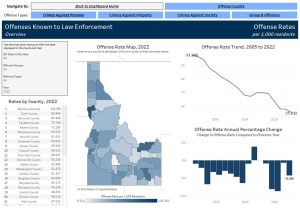 Crime in Idaho Data Dashboard
Crime in Idaho Data Dashboard
ISAC and the Idaho Uniform Crime Reporting (UCR) Program have collaborated to visualize data from the annual Crime in Idaho reports dating back to 2005. Idaho has been collecting UCR data utilizing the National Incident-Based Reporting System (NIBRS) since the mid-1990s. Developed by the Federal Bureau of Investigation, the NIBRS program provides a national standardized method for collecting detailed, reliable crime data from law enforcement agencies.
Idaho’s UCR Program is administered by the Bureau of Criminal Identification, Idaho State Police. Learn more about Idaho’s UCR Program and view the Crime in Idaho report series at the Idaho UCR Program’s website.
UPDATE SCHEDULE: Annually, on or around July 1st.
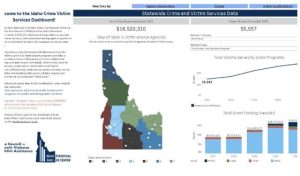 Idaho Crime Victim Services Dashboard
Idaho Crime Victim Services Dashboard
ISAC and the Idaho Council on Domestic Violence and Victim Assistance (ICDVVA) have collaborated to compile, analyze, and visualize multiple data sources that focus on the experience of crime victims in Idaho’s justice system. It is intended to be a resource for state and local policymakers, victim service agencies and program managers, and the general public to better understand the full scope of crime and victimization in the state. The dashboard currently includes data on community demographics, crime victims who reported their victimization to law enforcement, and crime victims served by a federally funded victim service program in Idaho.
UPDATE SCHEDULE: Annually, each winter.
Additional Data Dashboards, ISAC Publications, & Resources
 SEOW Data Dashboard
SEOW Data Dashboard
ISAC and the State Epidemiological Outcomes Workgroup (SEOW) (coordinated by the Idaho Office of Drug Policy) have collaborated to compile and visualize 100 indicators from 10 sources on substance use and misuse in Idaho. Policymakers, practitioners, and the public can use the dashboard to identify trends and emerging issues of interest to them and use the data to plan programs and other activities aimed at addressing those issues or preventing substance misuse in their communities.
The SEOW is a state-level advisory committee that provides information and guidance to policymakers and practitioners working to improve behavioral health among all Idahoans. Its members include owners of epidemiological and other data sources, representatives of agencies impacting behavioral health in Idaho, and others with data-related skills or data decision-making authority relating to behavioral health.
UPDATE SCHEDULE: TBD
 STOP Accomplishments
STOP Accomplishments
This dashboard presents data collected by local government and non-profit agencies receiving funding under the STOP VAWA grant program between 2014 and 2022.
Administered on the state level by the Planning, Grants & Research (PGR) Department of the Idaho State Police, the STOP (Services, Training, Officers, and Prosecutors) grant is a federal pass-through funding program authorized by Congress as part of the Violence Against Women Act (VAWA). STOP funds originate in the U.S. Department of Justice’s Office on Violence Against Women, and are passed through to local agencies to support communities in their efforts to develop and strengthen effective criminal justice strategies to address domestic violence, sexual assault, stalking, and dating violence; and develop and enhance victim services in cases involving these crimes. Learn more about Idaho’s STOP program on PGR’s Grant Opportunities & Programs page.
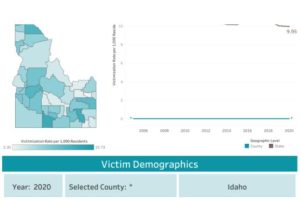 Idaho Victimization Clearinghouse Data Dashboard
Idaho Victimization Clearinghouse Data Dashboard
ISAC partnered with the Department of Criminal Justice at Boise State University (BSU) to build a dashboard displaying data related to violent crime victimization in Idaho. The Idaho Victimization Clearinghouse (IDVCH) Data Dashboard contains data crime victims who reported their victimization to law enforcement and/or received services from a federally funded victim service program in Idaho, as well as Idaho population and economic data.
ISAC also produced a report detailing the dashboard data selection process, an overview of the available data on crime victims in Idaho, and statistical tests performed on the data. Read the statistical report here.
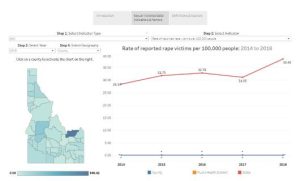 Idaho Sexual Violence Data Surveillance System
Idaho Sexual Violence Data Surveillance System
ISAC partnered with the Sexual Violence Prevention (SVP) Program at the Idaho Department of Health and Welfare to build a surveillance system and public-facing interactive data dashboard to monitor indicators of sexual violence in Idaho. The system is designed to be a resource for those interested in tracking indicators of sexual violence, including SVP and its subgrantees. Starting with a list of indicators selected by the SVP’s Evaluation Advisory Committee, ISAC selected 43 indicators to include in the system.
ISAC also performed statistical tests on 14 indicators. The companion report summarizes the process of indicator selection, as well as the results of the statistical analyses. Read the statistical report here.
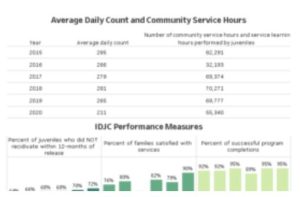 Idaho Criminal Justice Commission Data Sharing Platform
Idaho Criminal Justice Commission Data Sharing Platform
Developed and maintained by ISAC, the Idaho Criminal Justice Commission (ICJC) Data Sharing Platform presents performance measurement data contributed by ICJC’s Research Alliance member agencies.
The Research Alliance is a subcommittee of ICJC that directly supports the Commission in working toward two of its goals: (1) advance delivery of justice through effective interventions by proposing balanced solutions, which are cost effective and based on best practices; and (2) promote well-informed policy decisions. Its membership includes research and data experts from many of ICJC’s member agencies.
 Crime Victim Services in Idaho
Crime Victim Services in Idaho
This dashboard presents data from a myriad of sources on the state of crime victim services across Idaho. Users will find data on violent crime victimization rates, the location of victim service agencies, grant funding for service provision distributed to agencies and the number of victims served with those funds, claims paid out to victims by the Idaho Crime Victims Compensation Program, and more. Most of the data covers a 7-year period between 2012 and 2018.
The Crime Victim Services dashboard was one part of a two-part project funded by the Center for Victim Research. The collaborative effort between ISAC, the Idaho Council on Domestic Violence and Victim Assistance, the Idaho Crime Victims Compensation Program, and the Idaho Network of Children’s Advocacy Centers also included a report on the availability of forensic interviews in Idaho. Read the report on forensic interviews here.
Drug & Alcohol Related Crime Trends, 2005 – 2024
August 2025
This research brief presents analysis of data from the Idaho Incident-Based Reporting System (IIBRS) on crimes related to drugs and alcohol. The brief includes state-level analyses, county-level arrest rates for 2024, and highlights how the nature of drug and alcohol related crime in Idaho has changed since 2005.
Although the rate of total drug and alcohol offenses fluctuated between 2005 (19.1 offenses per 1,000 residents) and 2024 (16.7), the drug offense rate increased 38% during that time while the alcohol offense rate decreased 55%. In 2024, 24% of all offenses reported to IIBRS were drug or alcohol offenses, up from 9% in 2005. A growing number of arrestees are older (average age 33.8 years old in 2024, compared to 27 in 2005), female (29% in 2024, compared to 24% in 2005), and racial/ethnic minorities (68% white and non-Hispanic in 2024, compared to 82% in 2005). The percentage of person and/or property crime offenders suspected of being under the influence of drugs and/or alcohol during the commission of the crime nearly doubled to 9.6% in 2024 (up from 5.2% in 2005).
The full dataset is available in ISAC’s Crime in Idaho Data Dashboard.
School Resource Officers in Idaho
June 2025
This report presents an overview of school resource officer (SRO) programs in Idaho. It includes results of a large survey of school resource officers (SROs), school administrators, and elected school board members, as well as analysis of data on criminal offenses that occur on K-12 school grounds.
Statewide, just over 2% all criminal offenses recorded in 2023 occurred on K-12 school grounds. Most of these offenses were simple assaults (24%), drug/narcotic violations (24%) or drug equipment violations (15%). 90% of offenders were juveniles and 67% were male. In 2023, there were about 191 SRO positions across 77 (67%) of Idaho’s public school districts. Districts with an SRO program accounted for about 92% of Idaho’s public school enrollment.
On average, SROs reported spending more time in a law enforcement role and less time in a teaching role than school administrators and board members thought they should. More than 90% of school administrators and board members agreed that SROs improve school safety, prevent and/or reduce crime on campus, and build and/or improve relationships between law enforcement and youth. However, challenges noted by survey respondents included a lack of resources (primarily funding) to support SRO programs, balancing core SRO duties with other needs of law enforcement agencies and schools, and a lack of uniformity around the state regarding SRO qualifications, training, and SRO roles/responsibilities on campus.
Intimate Partner Violence in Idaho, 2023
April 2025
This research brief presents analysis of data on intimate partner violence from the Idaho Incident-Based Reporting System (IIBRS) and the Idaho Crime Victim Services Dashboard. The brief includes state-level data analysis, county-level victimization rates for 2023, and highlights the resource needs of victim service agencies in Idaho.
The number of intimate partner violence (IPV) victims known to law enforcement declined 7% between 2016 and 2023, while the number of IPV victims who received grant-funded victim services rose by 38%. In 2023, the number of victims who received grant-funded services (22,724) was more than four times higher than the number known to law enforcement (5,585).
In their 2023 annual reports, victim service agencies receiving grant funds from the state reported that their most urgent needs include additional resources to expand services, especially to rural areas; more and better training for all parts of the justice system on how to better serve victims of sexual and intimate partner violence, including more awareness of the services available among first responders and the community as a whole; and adding more sexual assault nurse examiners (SANEs) to increase access to forensic medical exams.
Sexual Violence in Idaho, 2023
April 2025
This research brief presents analysis of data on sexual violence from the Idaho Incident-Based Reporting System (IIBRS) and the Idaho Crime Victim Services Dashboard. The brief includes state-level data analysis, county-level victimization rates for 2023, and highlights the resource needs of victim service agencies in Idaho.
The number of sexual assault victims known to law enforcement rose 2% between 2016 and 2023, while the number of sexual assault victims who received grant-funded victim services also rose by 2%. In 2023, the number of victims who received grant-funded services (7,163) was nearly four times higher than the number known to law enforcement (1,841).
In their 2023 annual reports, victim service agencies receiving grant funds from the state reported that their most urgent needs include additional resources to expand services, especially to rural areas; more and better training for all parts of the justice system on how to better serve victims of sexual and intimate partner violence, including more awareness of the services available among first responders and the community as a whole; and adding more sexual assault nurse examiners (SANEs) to increase access to forensic medical exams.
Sexual Violence in Idaho: Prevalence and Health Impacts
November 2024
***Winner of the Justice Information Resource Network’s 2025 Douglas Yearwood Award for Best Statistical/Management Report by a Small SAC!***
This research brief presents data from the Idaho Behavioral Risk Factor Surveillance System on the prevalence of sexual violence in Idaho, and the adverse health impacts associated with sexual violence victimization.
Results indicate that sexual violence is far more widespread than administrative data from law enforcement and victim service agencies indicates. An estimated 13.6% of adult Idahoans have experienced sexual violence at some point in their lives, and 13.5% have a history of childhood sexual abuse. Demographic groups at higher risk for experiencing sexual violence include young adults (ages 18 – 34), individuals living in income-constrained households, females, and those who identify as LGBTQ. Additionally, victims of sexual violence experience adverse health outcomes at significantly higher rates than those who have never experienced sexual violence, including poor physical and/or mental health, drug/alcohol use or misuse, and other adverse childhood experiences (ACEs) beyond childhood sexual abuse.
2024 Idaho Justice System Stakeholder Survey
October 2024
This report presents results from ISAC’s 2024 survey of stakeholders from across six sectors of Idaho’s justice system: law enforcement, juvenile justice, adult corrections, victim services, judiciary/courts, and elected officials. ISAC conducts this survey every five years as part of PGR’s strategic planning initiatives.
ISAC found that two main themes (mental health/substance use treatment, housing) emerged as top priorities for stakeholders. “Crime related to mental illness” and “illicit drug use” were two of the five most commonly chosen answers by respondents when asked to name their top three public safety issues. Regarding housing, respondents in three sectors ranked items related to housing as top-five needs in their communities. ISAC recommends the state, particularly grant administrators, should prioritize funding and programs that address these two issues.
Substance Use in Idaho: Overview of Data from the State Epidemiological Outcomes Workgroup
May 2024
This report presents analysis of data collected for the SEOW Data Dashboard. The State Epidemiological Outcomes Workgroup (SEOW), coordinated by the Idaho Office of Drug Policy (ODP), is a state-level working group that advises ODP and other state agencies on trends, emerging issues, and best practices in substance use and misuse prevention. The SEOW Data Dashboard, which compiles and visualizes over 100 indicators from 10 sources, is a new resource that helps shed light on the overall nature of substance use and misuse around the state.
ISAC found that there is far more data available on alcohol, tobacco, and marijuana than for emerging substances of concern like fentanyl. Overall, fewer Idahoans aged 12 and over report using alcohol and marijuana than the national average, but more than 10% of Idaho adults have unmet alcohol misuse treatment needs, and attitudes towards marijuana use among adults has shifted since 2015. Regarding opioids and fentanyl, Idaho’s overdose death rate for both substances has increased substantially since 2012.
Idaho Crime Data
- Idaho Uniform Crime Reporting (UCR) Program: Managed by the Bureau of Criminal Identification at the Idaho State Police, the Idaho UCR Program serves as the state repository for the collection of crime statistics. The program’s primary objective is to compile reliable information for use in law enforcement administration, operation, and management.
- Idaho Department of Correction: Population and demographics, Community Gap Analysis, JRI Impact Report, Program Evaluation Reports, etc.
- Idaho Department of Juvenile Corrections: Publications, reports, statistics, and demographics.
- Idaho Court Data: Explore Idaho criminal and civil court filings, Court financial data, and more.
National Crime Data
- Justice Information Resource Network: The Justice Information Resource Network (JIRN) is a national nonprofit organization dedicated to the use of nonpartisan research and analysis to inform criminal and juvenile justice decision-making. ISAC is an active member of JIRN.
- Bureau of Justice Statistics: The primary statistical agency of the U.S. Department of Justice.
- National Archive of Criminal Justice Data: The National Archive of Criminal Justice Data provides datasets that can help guide the exploration and extension of research ideas for topics connecting technology and criminology.
- National Criminal Justice Reference Service (NCJRS): NCJRS is a federally funded resource offering justice and drug-related information to support research, policy, and program development worldwide.
- FBI’s Crime Data Explorer: The FBI’s Crime Data Explorer aims to provide transparency, create easier access, and expand awareness of criminal, and noncriminal, law enforcement data sharing; improve accountability for law enforcement; and provide a foundation to help shape public policy with the result of a safer nation.
- Office for Victims of Crime
- Urban Institute
- National Institute of Justice
- National Center for Health Statistics
- Office of Juvenile Justice and Delinquency Prevention – Statistical Briefing Book
Related Data Sources
- Indicators Idaho: Developed by the University of Idaho, this site provides a one-stop source of up-to-date information on Idaho, as well as its counties, reservations, and tribes.
- Idaho Department of Health and Welfare – Reports and Statistics
- Get Healthy Idaho – Population Health Data: This site functions as a resource for sharing population health data, especially for measures which provide a snapshot of the overall health of Idahoans.
- Idaho Office of Drug Policy: Idaho Healthy Youth Survey, Idaho Substance Abuse Needs Assessment
- Centers for Disease Control and Prevention WONDER: Online databases utilize a rich ad-hoc query system for the analysis of public health data.
- Center for Victim Research: The Center for Victim Research is designed to serve as a one-stop shop for victim service providers and researchers to connect and share knowledge to increase access to victim research and data, and the utility of research and data collection to crime victim services nationwide.
ISAC Publication Archive
This Web site is funded through a grant from the Bureau of Justice Statistics, Office of Justice Programs, U.S. Department of Justice. Neither the U.S. Department of Justice nor any of its components operate, control, are responsible for, or necessarily endorse this website (including, without limitation, its content, technical infrastructure, policies, or any services provided).
We appreciate any questions or comments regarding our website, dashboards, or publications. Contact: ISAC Director Thomas Strauss at 208-884-7047.
